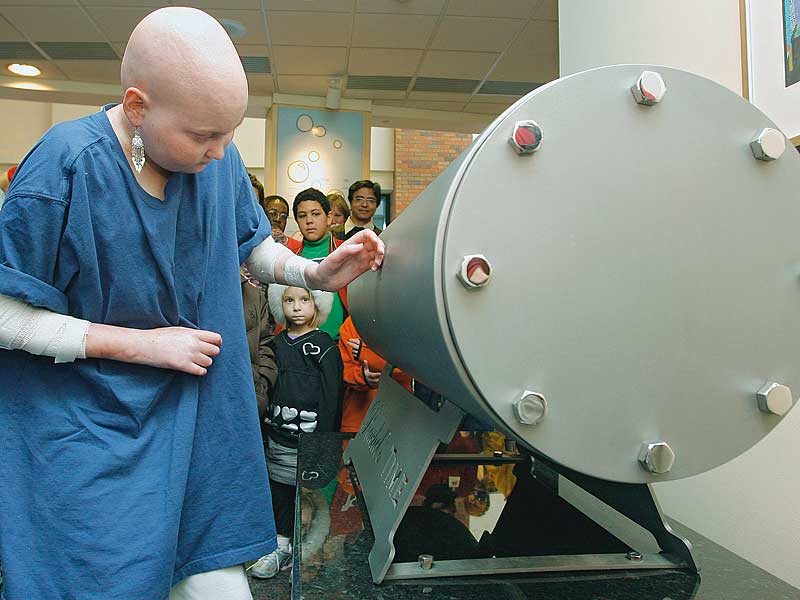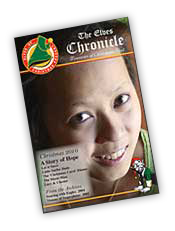A young history buff finds she’s front-page news in the 22nd century
Midmorning Christmas Eve, two pointy-hatted visitors crunched up the snow-covered driveway of 15-year-old Rachel Hoffmanʼs Olathe home.
They thumped on the door.
“Are you Rachel?” the bigger one asked.
Rachel nodded.
“Merry Christmas.”
The pair pressed a letter into her hands, turned back through the door and left without another word.
Dear Rachel,
Weʼre very sorry, but we accidentally delivered your Christmas present to the wrong place…
The note explained that things were busy, and they checked the list twice, but even elves get tired. Rachel would find her gift, all wrapped up, in the lobby of Childrenʼs Mercy Hospital.
P.S. You really donʼt have to mention this to the big guy.
Rachel thought her mom had been acting funny, and now she knew something was up.
Torie Clarke had been in contact with the Elves of Christmas Present, an anonymous group that secretly arranges surprises for a few local people who could use a lift at Christmastime. This year, one of them was to be her daughter Rachel.
Clarke had been sitting on a big secret for a while — and she still had a half- hour car ride to the hospital to go.
It was almost three years ago when Rachel tagged along one day as her younger sister, Karin, went to see an asthma and allergy specialist.
When the nurse practitioner walked in the room and saw Rachel, then 12, she stopped. Rachel was too pale. Had her hemoglobin been checked lately?
Within weeks, Rachel and her family learned she had acute myeloid leukemia, with myeloid dysplasia, with monosomy 7 syndrome.
Basically, she had a severe form of leukemia that chemotherapy couldnʼt cure. A bone marrow transplant would provide her only chance at survival, said physician Jignesh Dalal, her pediatric bone marrow transplant doctor at Childrenʼs Mercy.
The transplant exchanged Rachelʼs abnormal cells for new ones. But after a few months, the donor cells began rejecting their host, Rachelʼs body, Dalal said.
That was more than two years ago.
Rachel and her parents read all they can about new treatments, but theyʼre wary of the statistics they see in medical jour- nals. According to some, “she shouldnʼt be alive right now,” Clarke said. But they have been open to new treatments, trying a different shot or drug regimen in hopes it might work.
“Thank you, God, so far it is.”
“I wonder whose idea this is?” Rachel mused as Clarke sped up Interstate 35.
“You donʼt even know what the surprise is yet,” Clarke reminded her, trying to tease her into guessing.
Rachel knew better than to think her mom would crack.
But, as she and 13-year-old Karin pointed out, they had seen some kind of mysterious “elf guy” on Clarkeʼs Palm Pilot.
Rachelʼs illness forced her to leave school, first for weeks of tests, then for longer stretches while she underwent treatment.
Eventually, she stopped going altogether. Crowds are too risky for her delicate immune system, and navigating the halls for an entire day is unquestionably too tiring.
Even in her home-study program, social studies and history remain her favorite subjects.
When the Dream Factory offered her a trip, Rachel chose Washington, D.C. “Thereʼs just so much history there,” she said.
In June, she and her mother saw all the sights, but one of the most memorable experiences of Rachelʼs life happened at the United States Holocaust Memorial Museum, where she met a survivor face to face.
Rachel was in awe hearing how the man overcame a situation in which he had no control, lost his family and feared for his own life. On top of that, he had the fortitude to rehash those memories and share his story with others.
“How do you survive that?” she said. “How much courage would that take?”
She admires figures like Gandhi and is fascinated by medieval times, too.
But, Rachel said, if she could transport herself back in time, it would be to Malaysia, around 1997.
Rachelʼs parents were still together, and her dad, Willie Hoffman, had a job there. The family lived there for four years, until Rachel was 8.
The first years of her education were at an international school. Multilingual conversations filled the cafeteria. In addition to electives such as art and music, students studied different cultures. She said the students there seemed to be intellectually curious, appreciated what they had and looked at the world differently than the ones she encountered later in the suburbs.
A yearbook has pictures of Rachel in traditional Asian dress, blond-haired, made up and smiling for a dance performance.
“Things were so much simpler,” she said. “Well, not simpler, but easier, made more sense.”
Rachel and her family have taken a hands-on — and hopeful — approach to her treatment.
Rachel figures sheʼll never understand why this happened to her. But sheʼd at least like to understand whatʼs going on.
“When I get older, whoʼs going to do it for me?”
Rachel can pronounce all the polysyllabic drugs she has to swallow, normally nearly 20 pills in the morning and almost as many at night. She knows (down to the cellular level) what each is for, which ones cause what side effects, and which ones counteract them. She knows which ones taste bad, and to tuck those into a capsule to make them go down easier.
She knows what the injection port looks like under her skin — and can draw it on a sticky note.
Rachel also knows that the donor rejection is whatʼs causing her scleroderma. Instead of being soft and pliable, her skin has become dry, smooth and hard, like plastic.
It itches. It breaks out in sores. Itʼs so hard that it hurts to bend, and she canʼt stand up straight.
She knows that the same hardening is happening inside her lungs, making it more and more difficult to breathe.
Rachel spends half her time at her momʼs house and half at her dadʼs. She easily speeds through 850-page fantasy novels, mainly by reading “way too late at night,” she said.
She braids colored-yarn bookmarks and writes often — with impeccable penmanship — to her stepfather, Shane Clarke, who is in Iraq with the National Guard.
Torie Clarke said the family had just signed up for a hospice and palliative care program, so Rachel will soon have in-home physical therapy, along with art therapists and volunteers to keep her company.
With sister Karin right behind, Clarke whisked Rachelʼs wheelchair through the parking garage, up the elevator and into the Childrenʼs Mercy lobby.
It was full — of people she knew.
Smiling family members, friends and hospital staffers circled a Christmas tree, where Rachel found her first gift.
Young elves, including the one who knocked on her door, handed her another note.
For the girl who loves history — now you can be a part of it.
Love, The Elves
They helped her unwrap a framed newspaper front page dated Dec. 24, 2107.
The paper reported that the Chiefs were still trying to make the playoffs, that Kansas City was exploring light rail — and that Clay Chastain IV was threatening a lawsuit.
One story said medical advancements had done away with painful procedures and all but abolished some of the worst diseases of the 21st century.
The top story, though, was about dignitaries unearthing a time capsule filled 100 years ago by a 15-year-old patient named Rachel Hoffman, who had been diagnosed with what was then a serious illness.
Inspired by Rachelʼs love of history, the article said, a group known as the Elves of Christmas Present had crafted a time capsule for her to fill.
The capsuleʼs contents provided a glimpse into “turn of the century” medical treatments and what it was like to be a patient at Childrenʼs Mercy.
Rachel beamed, bigger as her mother read aloud the parts about what she “had” done.
But the plan didnʼt just exist in a make- believe newspaper.
“So there must be a time capsule,” Clarke finally gushed. “You want to see it?”
As Clarke wheeled Rachel around, people standing in a corner parted to reveal a hulking object draped with evergreen- colored blankets and a giant red bow.
Rachel lifted herself to her feet and slowly pulled away the coverings, revealing a stainless-steel cylinder, complete with industrial-strength bolts and valves for inserting nitrogen, atop a gleaming block of black granite — all fabricated by elves with special talents. Laser-cut into the capsuleʼs steel base was “Rachelʼs Time.”
“Wowwww,” she whispered, running her hands across the steel. “Thatʼs so cool.”
For the next couple of months, Rachel will have the help of a professional historian to fill the time capsule, which will remain at Childrenʼs Mercy Hospital.
The wheels were already turning when she tilted her head and smiled to the crowd moments after seeing her gift.
“So, what are we going to put in it?”
Sara Shepard, The Kansas City Star


